A) a compass needle would point south
B) the magnetic signal of seafloor formed with this polarity would be stronger compared to adjacent areas of the seafloor
C) there are much fewer intervals of reversed polarity than normal polarity
D) all of these
Correct Answer

verified
Correct Answer
verified
Multiple Choice
Which location on this figure from the Investigation is located on the abyssal plain? 
A) 1
B) 2
C) 3
D) 4
E) 5
Correct Answer

verified
Correct Answer
verified
Multiple Choice
Mantle convection involves the asthenosphere moving upward due to its lower:
A) density
B) temperature
C) mineral content
Correct Answer

verified
Correct Answer
verified
Multiple Choice
On the accompanying figure, what type of feature is located in the area of number 2? 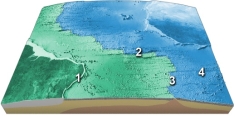
A) transform fault
B) mid-ocean ridge
C) linear island chain
D) fracture zone
Correct Answer

verified
Correct Answer
verified
Multiple Choice
This figure shows plate boundaries south of Alaska. Which location is on a transform boundary? 
A) 1
B) 2
C) 3
D) 4
E) 2 and 3
Correct Answer

verified
Correct Answer
verified
Multiple Choice
Why does the Tibetan Plateau, shown in this figure, have a high elevation? 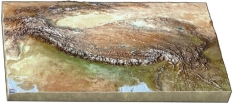
A) transform faulting
B) seafloor spreading
C) continental rifting
D) continental collision
E) hot-spot activity
Correct Answer

verified
Correct Answer
verified
Multiple Choice
Mid-ocean ridges are higher than surrounding oceanic crust primarily because:
A) two plates are colliding
B) the crust is thicker
C) the crust is stronger
D) transform faulting uplifts the rocks
E) the lithosphere is thinner and hotter
Correct Answer

verified
Correct Answer
verified
Multiple Choice
What is the underlying geologic explanation for why western South America is so different from eastern South America?
A) The western side is a plate boundary and the eastern side is not.
B) The eastern side is a plate boundary and the western side is not.
C) The western side marks a plate divergence and the eastern side marks a plate convergence.
Correct Answer

verified
Correct Answer
verified
Multiple Choice
Island chains and seamounts cross parts of the ocean floor. These oceanic islands and associated seamounts are:
A) different in character and origin from curved island arcs
B) the same in character but different in origin from curved island arcs
C) different in character but the same in origin from curved island arcs
Correct Answer

verified
Correct Answer
verified
Multiple Choice
What causes magnetic stripes on the seafloor, such as those shown here? 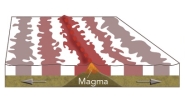
A) Volcanic rocks in oceanic crust are covered by a variable thickness of sediment.
B) Some oceanic crust consists of volcanic rocks and some is composed of sediment.
C) Sometimes Earth's magnetic field points north and sometimes it points south.
D) Some volcanic rocks are formed in normal ways and others have pillows.
Correct Answer

verified
Correct Answer
verified
Multiple Choice
Which of the following features is present on the seafloor off the Pacific Northwest? 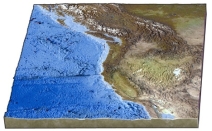
A) world's largest oceanic plateau
B) long, fairly straight fracture zone
C) world's largest linear island chain
D) island arc within oceanic plates
Correct Answer

verified
Correct Answer
verified
Multiple Choice
Intense geologic activity occurs at plate:
A) boundaries
B) centers
C) bottoms
Correct Answer

verified
Correct Answer
verified
Multiple Choice
Convergence of two ocean plates forms an ocean-ocean:
A) convergent boundary
B) divergent boundary
C) transform boundary
Correct Answer

verified
Correct Answer
verified
Multiple Choice
On this map of the South Atlantic, which letter is on a site of seafloor spreading? 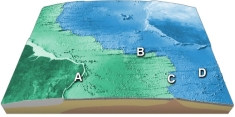
A) A
B) B
C) C
D) D
E) E
Correct Answer

verified
Correct Answer
verified
Multiple Choice
A divergent plate boundary is most likely associated with an) :
A) oceanic trench
B) mountain belt or island arc
C) mid-ocean ridge
D) none of these
Correct Answer

verified
Correct Answer
verified
Multiple Choice
Broad symmetrical ridges that cross ocean basins are called:
A) mid-ocean ridges
B) abyssal plains
C) seamounts
D) island chains
Correct Answer

verified
Correct Answer
verified
Multiple Choice
What types of plate boundaries are shown in this figure? 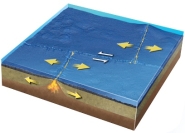
A) divergent
B) convergent
C) transform
D) divergent and transform
E) convergent and divergent
Correct Answer

verified
Correct Answer
verified
Multiple Choice
On this map, identify which letter is over the Pacific Ocean. 
A) A
B) B
C) C
D) D
E) feature is not labeled
Correct Answer

verified
Correct Answer
verified
Multiple Choice
As two oceanic plates diverge at mid-ocean ridges, melting of the rising mantle occurs due to:
A) decompression
B) the addition of heat
C) the addition of water
Correct Answer

verified
Correct Answer
verified
Multiple Choice
Which of the following best represents the sequence by which a continent splits apart?
A) seafloor spreading, then continental rifting, then uplift due to mantle upwelling
B) continental rifting, then seafloor spreading, then uplift due to mantle upwelling
C) uplift due to mantle upwelling, then continental rifting, then seafloor spreading
D) none of these
Correct Answer

verified
Correct Answer
verified
Showing 61 - 80 of 152
Related Exams